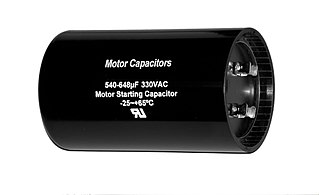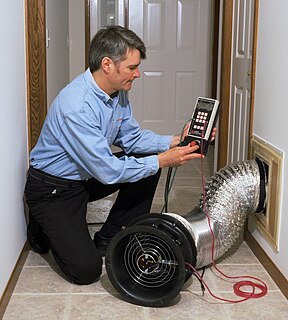
Heating, ventilation, and air conditioning (HVAC) is the use of various technologies to control the temperature, humidity, and purity of the air in an enclosed space. Its goal is to provide thermal comfort and acceptable indoor air quality. HVAC system design is a subdiscipline of mechanical engineering, based on the principles of thermodynamics, fluid mechanics, and heat transfer. "Refrigeration" is sometimes added to the field's abbreviation as HVAC&R or HVACR, or "ventilation" is dropped, as in HACR.

A thermostat is a regulating device component which senses the temperature of a physical system and performs actions so that the system's temperature is maintained near a desired setpoint.
HVAC equipment needs a control system to regulate the operation of a heating and/or air conditioning system. Usually a sensing device is used to compare the actual state with a target state. Then the control system draws a conclusion what action has to be taken.

A brushless DC electric motor, also known as an electronically commutated motor or synchronous DC motor, is a synchronous motor using a direct current (DC) electric power supply. It uses an electronic controller to switch DC currents to the motor windings producing magnetic fields which effectively rotate in space and which the permanent magnet rotor follows. The controller adjusts the phase and amplitude of the DC current pulses to control the speed and torque of the motor. This control system is an alternative to the mechanical commutator (brushes) used in many conventional electric motors.

A ceiling fan is a fan mounted on the ceiling of a room or space, usually electrically powered, that uses hub-mounted rotating blades to circulate air. They cool people effectively by increasing air speed. Fans do not reduce air temperature or relative humidity, unlike air-conditioning equipment but create a cooling effect by helping to evaporate sweat and increase heat exchange via convection. Fans may add a small amount of heat to the room mainly due to waste heat from the motor, though partially due to friction. Fans use significantly less power than air conditioning as cooling air is thermodynamically expensive. In the winter a ceiling fan can also be used to bring warm air, which naturally rises, back down to occupants. This can affect both thermostat readings and occupants' comfort, thereby improving climate control energy efficiency. Many ceiling fan units also double as light fixtures, eliminating the need for separate overhead lights in a room.
Johnson Electric (德昌電機控股有限公司) is a provider of motors, actuators, motion subsystems and related electro-mechanical components for automotive, industrial and medical applications. Johnson Electric has manufacturing facilities in 22 countries.

UTC Climate, Controls & Security was a global provider of building technologies offering fire safety, security, building automation, heating, ventilating, air-conditioning, and refrigeration systems and services. A wholly owned subsidiary of United Technologies Corporation, UTC Climate, Controls & Security was a $16.7 billion company with 55,000 employees serving customers in more than 180 countries.

An air handler, or air handling unit, is a device used to regulate and circulate air as part of a heating, ventilating, and air-conditioning (HVAC) system. An air handler is usually a large metal box containing a blower, heating or cooling elements, filter racks or chambers, sound attenuators, and dampers. Air handlers usually connect to a ductwork ventilation system that distributes the conditioned air through the building and returns it to the AHU. Sometimes AHUs discharge (supply) and admit (return) air directly to and from the space served without ductwork

Regal Rexnord Corporation, usually referred to as just Regal Rexnord, is a manufacturer of electric motors and power transmission components headquartered in Beloit, Wisconsin. The company has manufacturing, sales, and service facilities throughout the United States, Canada, Mexico, Europe and Asia, with about 29,000 employees. As of year 2021, the company is ranked 763rd on the Fortune 1000, and was the 17th largest corporation in Wisconsin.
A hybrid heat system reacts to changing temperatures and automatically adjusts to the most efficient energy saving method available to heat or cool a home. It can be a fuel-saving alternative to traditional heating and cooling systems in that it combines a furnace with a heat pump, rather than an air conditioner.

A fan is a powered machine used to create a flow of air. A fan consists of a rotating arrangement of vanes or blades, generally made of wood, plastic, or metal, which act on the air. The rotating assembly of blades and hub is known as an impeller, rotor, or runner. Usually, it is contained within some form of housing, or case. This may direct the airflow, or increase safety by preventing objects from contacting the fan blades. Most fans are powered by electric motors, but other sources of power may be used, including hydraulic motors, handcranks, and internal combustion engines.

A fan coil unit (FCU), also known as a Vertical Fan Coil-Unit (VFC), is a device consisting of a heat exchanger (coil) and a fan. As part of an HVAC system found in residential, commercial, and industrial buildings using ducted split air conditioning or with central plant cooling, a fan coil unit is often connected to ductwork and a thermostat to regulate the temperature of one or more spaces as well as assisting the main air handling unit for each space if used with chillers. The thermostat controls the fan speed and/or the throughput of water to the heat exchanger using a control valve.

A motor capacitor, such as a start capacitor or run capacitor is an electrical capacitor that alters the current to one or more windings of a single-phase alternating-current induction motor to create a rotating magnetic field.
HVAC is a major sub discipline of mechanical engineering. The goal of HVAC design is to balance indoor environmental comfort with other factors such as installation cost, ease of maintenance, and energy efficiency. The discipline of HVAC includes a large number of specialized terms and acronyms, many of which are summarized in this glossary.

A duct leakage tester is a diagnostic tool designed to measure the airtightness of forced air heating, ventilating and air-conditioning (HVAC) ductwork. A duct leakage tester consists of a calibrated fan for measuring an air flow rate and a pressure sensing device to measure the pressure created by the fan flow. The combination of pressure and fan flow measurements are used to determine the ductwork airtightness. The airtightness of ductwork is useful knowledge when trying to improve energy conservation.
Trane Technologies is an Irish-domiciled holding company focused on the manufacturing of heating, ventilation, and air conditioning (HVAC) and refrigeration systems. The company traces its corporate history back more than 150 years and was created after a series of mergers and spin offs. In 2008, HVAC manufacturer Trane was acquired by Ingersoll Rand, an industrial tools manufacturer. In 2020, the tools business was spun off as Ingersoll Rand and the remaining company was renamed Trane Technologies.
The ebm-papst Group is a manufacturer of electric motors and fans. It came into existence in 2003 when the companies Elektrobau Mulfingen GmbH & Co. KG (ebm), Papst Motoren GmbH in St. Georgen and Motoren Ventilatoren Landshut GmbH (mvl) merged. The company employs around 13,000 employees at 25 production facilities and 49 sales offices worldwide. The headquarters is located in Mulfingen in the Hohenlohe district of Germany.
Variable refrigerant flow (VRF), also known as variable refrigerant volume (VRV), is an HVAC technology invented by Daikin Industries, Ltd. in 1982. Like ductless minisplits, VRFs use refrigerant as the cooling and heating medium. This refrigerant is conditioned by one or more condensing units, and is circulated within the building to multiple indoor units. VRF systems, unlike conventional chiller-based systems, allow for varying degrees of cooling in more specific areas, may supply hot water in a heat recovery configuration without affecting efficiency, and switch to heating mode during winter without additional equipment, all of which may allow for reduced energy consumption. Also, air handlers and large ducts are not used which can reduce the height above a dropped ceiling as well as structural impact as VRF uses smaller penetrations for refrigerant pipes instead of ducts.

A high efficiency glandless circulating pump is a component of a heating and air conditioning system that allows the system to perform with increased efficiency while significantly reducing the system's electrical usage.
An inverter compressor is a gas compressor that is operated with an inverter.












